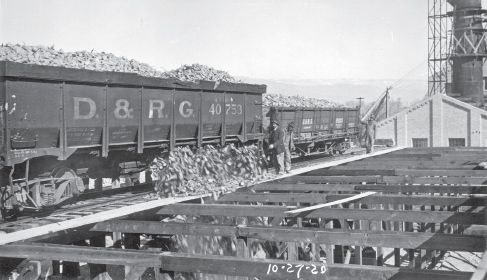
Workers unloading railroad carloads of sugar beets for processing at the Holly Sugar plant at Delta. Courtesy of History Colorado.
13
DELTA
Delta sits in an area of rich soil and fine silt deposits where the Gunnison and Uncompahgre Rivers come together. Antoine Robidoux, a trader from Santa Fe, built Fort Uncompahgre, near the south bank of the Gunnison River in 1828. There was plenty of wood for building, campfires, and heating and lots of grass for the horses of the Utes who came to the fort, eager to trade, especially for guns. Robidoux established several routes that he used to haul goods from St. Louis and Santa Fe to his trading post. The Mountain Branch of the Spanish Trail was much shorter, but it was very difficult. It ran north from Santa Fe, through the San Luis Valley of Southern Colorado, across Cochetopa Pass into the Gunnison River Valley to the fort. The other route, known as Robidoux’s Cutoff, was shorter, and the trader used it when he was bringing guns and goods from St. Louis. This trail bypassed Santa Fe and avoided customs with its high taxes.
The Utes traded their animal pelts and hides for guns, blankets, knives, tobacco, cloth, and beads. The sale or trade of guns was prohibited by both Spanish and Mexican law, but enforcement at remote Fort Uncompahgre was nearly impossible. Robidoux operated his trading post with about fifteen Mexican employees until 1843. That summer, trouble between the Utes and the Mexicans in Santa Fe broke out, and warfare spread through Southern Colorado to the Robidoux post. The Utes attacked the post and killed fourteen of his Mexican employees and seized all of the women. Only one worker escaped the carnage and managed to reach Taos two weeks later.
Antoine Robidoux had not been at the fort when the Indians attacked, and he never returned to the area, completely abandoning his business. The Utes later let him know their anger had been directed at the Mexicans, not him, and asked him to return. Robidoux refused, and about two years after the massacre, the Utes burned down the fort buildings.
In October 1881, when the Northern Utes were driven from Colorado and placed on the Uintah Reservation in Utah, settlers, town builders, farmers, and ranchers rushed to grab their lands. By the end of September 1882, all the choice parcels near the rivers had been taken. Delta County was created by the legislature in February 1883, with the county seat of Uncompahgre City. Since its citizens couldn’t spell or pronounce that name, the town soon became “Delta” because of its location at the confluence of the two rivers.
The Uncompahgre Valley around Delta and Montrose is very dry, receiving an average of seven inches of rain per year. The soil was rich, but water for irrigation was needed before any crops could be grown. Farmers dug ditches from the Uncompahgre River to the fields and planted their crops. Their first harvests were enormous, so more land was plowed, and more fields were planted, extending from Delta to Montrose. The valley produced all types of fruits and vegetables, including potatoes, onions, cherries, apples, corn, wheat, and other grains.
By 1909, the Denver & Rio Grande Railroad had completed its tracks through the valley and was carrying produce and livestock to markets in Denver and the mountain mining towns. The valley had over 5,700 bee colonies, and its honey won first place at the 1904 Chicago World’s Fair. Sugar beets thrived around Delta, and Holly Sugar built a large processing plant there in 1920.
As the number of established farms increased, it became obvious that the Uncompahgre River could not provide enough water for irrigation. The water supply dwindled, crops dried up, and families were forced to abandon their once productive farms. For twenty years, farmers in the dry valley struggled with the lack of water. They knew that just sixteen miles away there was plenty of water in the Gunnison River, which ran through the Black Canyon. A massive mountain range blocked this water from reaching the thirsty Uncompahgre Valley fields.
In 1904, a proposal for a large ditch to carry water from the Gunnison River was discarded in favor of boring a tunnel through the mountains. The United States Reclamation Service began the Gunnison Tunnel Project in 1905, and it took four years to complete. President William Howard Taft presided at the opening ceremonies for the 5.8-mile-long tunnel. It would enough carry water to irrigate 146,000 acres of farmland in Delta, Montrose, and Ouray Counties. The completion of Blue Mesa Reservoir and Dam in 1965 augmented the Western Slope’s water supply and supported growth in Delta, Paonia, Crawford, and the small agricultural towns. Now the orchards surrounding Delta produce two-thirds of Colorado’s apple crop, as well as apricots, cherries, nectarines, peaches, and plums.

Workers unloading railroad carloads of sugar beets for processing at the Holly Sugar plant at Delta. Courtesy of History Colorado.
During the 1980s, Delta began a project to give its Main Street a facelift. With financial help from the National Trust for Historic Preservation, more than one hundred trees were planted and a dozen murals were painted on the downtown buildings. In 1992, Delta won an All-American City award. The Delta County Historical Society Museum has many artifacts from the town’s early years, and it is especially proud of its collection of dinosaur bones that were found in this area.
The Historical Society is responsible for the care of the Council Tree, a cottonwood tree believed to be at least 215 years old. It is the sole survivor of an ancient grove located near a Ute trail and was an important meeting place for the Native Americans. The local chapter of the DAR recognized this historic connection to the Utes by placing a bronze plaque on the Council Tree in the 1930s. Through the years, strong winds and harsh weather have taken their toll on this tree, and the last living branch broke off and fell in August 2017. In the interest of public safety, the historical society decided to cut the top portion of the ancient tree down, leaving only a twenty-eight-foot-high trunk.
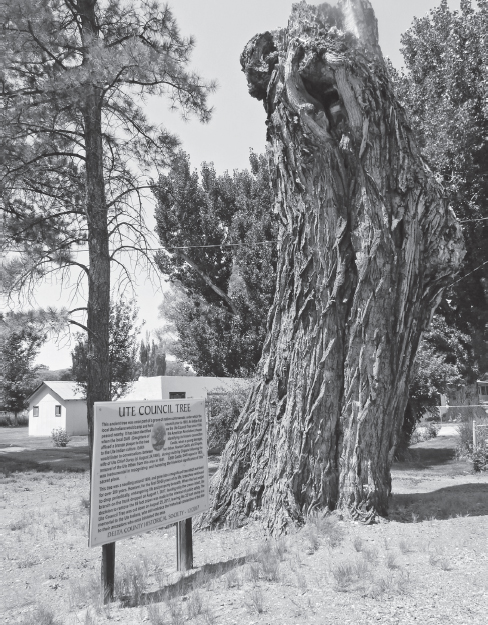
The Ute Council Tree is over two hundred years old and was a favorite meeting place of the Indians. Courtesy of Wendy Williams.
FAIRLAMB BED & BREAKFAST
The Fairlamb home was built by Millard and Stella Fairlamb in 1906, using locally manufactured bricks. The three-story, American Foursquare home sits on a bluff overlooking the delta formed by the Gunnison and Uncompahgre Rivers. Brothers, sisters, and other relatives of Millard and Stella built their homes along this street until the residences of the Fairlamb clan covered an entire city block.
The Fairlambs lived in this house for many years and raised their children here. Millard died in 1947, but Stella lived until 1968. Their home was passed down to their children and then their grandchildren and remained in the Fairlamb family for seventy-two years. The house was purchased around 1978 by two local physicians, who used it as a rental home. They had a number of different tenants over the years and sold it in February 1994 to Elizabeth Thompson and John Taylor.
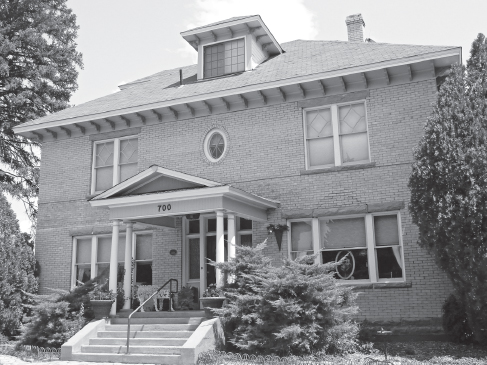
The Fairlamb House is a combination of American Four Square and Arts and Crafts architectural styles. Courtesy of Wendy Williams.
The years had taken their toll on the house, and it was desperately in need of repairs and a major renovation. Its rather plain American design was a contrast to the more ornate Victorian style of the 1890s and early 1900s. The house incorporated features of the Prairie and Arts and Crafts styles, which are characterized by a square, boxy house with dormers, a hipped roof, and plenty of Craftsman woodwork. Many of the original fixtures and special features of this home were gone, so replacements were salvaged from older buildings of the same period. The entry and front hall light fixtures came from an old school building in Washington State. An Arts and Crafts–style stained-glass and brass light fixture was once in an old Denver commercial building. The handsome grandfather clock was made by Elizabeth’s father, and the front door, inlaid hardwood floors, and the Arts and Crafts–style fireplace are original.
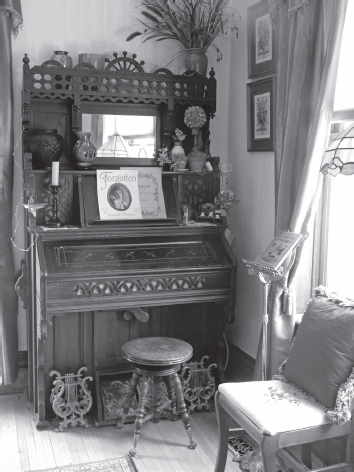
Pump organs were often played in family homes in the nineteenth century. Courtesy of Wendy Williams.
Today, the Fairlamb House is operated as a bed-and-breakfast. John and Elizabeth have maintained its post-Victorian style with antique furnishings and lace-curtained windows. There’s a vintage pump organ in the inviting library, where guests can relax and browse through the books.
There are three guest rooms on the third floor with two bathrooms, one with a claw-footed bathtub. The pastel flower wallpaper and white wrought-iron bedframe in the Stella Room contrast with the dark, wooden furniture in the Millard Room. The smaller Ethel Room has a brass bed with a canopy, and interestingly, the closet in this room was once a connecting passageway to the bedroom next door. A century ago, this was referred to as a “discretion closet.”
GHOSTS
The Fairlamb family really did have a skeleton—not in their closet but in their attic. Millard, who built the house, had a deep interest in the ancient tribes that lived in adobe cliff dwellings for centuries. He often searched for their ruins and artifacts, and on a trip to Utah, he found a human skeleton. Instead of notifying the authorities, he gathered up the bones, put them in a box, and took them home. Millard stored this box of bones in his attic, where they scared children who were bold enough to peek. The bones remained in the attic for years until they were given to the Utes for a proper burial. Now some people speculate that a wandering spirit may have been attached to these ancient bones, and it still hangs around the house.
Just a few years after John and Elizabeth purchased the home, they had Native American guests who were attending the Council Tree Pow Wow and Festival that’s held in Delta every fall. After spending one night in the Millard Room, the guests, a Lakota medicine man and his wife, said that the spirits of five women were trapped in the house. They had awakened to see these apparitions standing at their bedside. The medicine man performed a cleansing ceremony and smudged the entire house with burning sage. Then he called upon the angels and free spirits to help these trapped ghosts move on.
The apparitions of several ladies, wearing fashions of the early 1900s, have been seen around the house. They appear most often in the Millard Room but vanish quickly when they’re noticed. A rocking chair quietly moves back and forth when no one’s near, and the bathroom lights often flicker on and off. There’s been similar activity in both the Ethel and Stella bedrooms. Strange cold spots are noticed throughout the house, while disembodied voices, banging sounds, and mysterious footsteps are heard.
A pretty little seashell is often mysteriously moved around from place to place. It might be left on a shelf in one room, only to show up in an odd place in another room the following day. Occasionally, someone says they feel like they are being watched, or they sense an unseen presence. Some people theorize that the pieces salvaged from other vintage buildings may have come to the Fairlamb House with an attached spirit. When a team investigated the paranormal activity, they heard about a death years ago when a family member suffered a fatal fall from a ladder while hanging Christmas ornaments. They wonder if this tragedy might be responsible for the unexplained paranormal activity? Could the restless spirits in this house be related to the old bones that were stored in the attic?
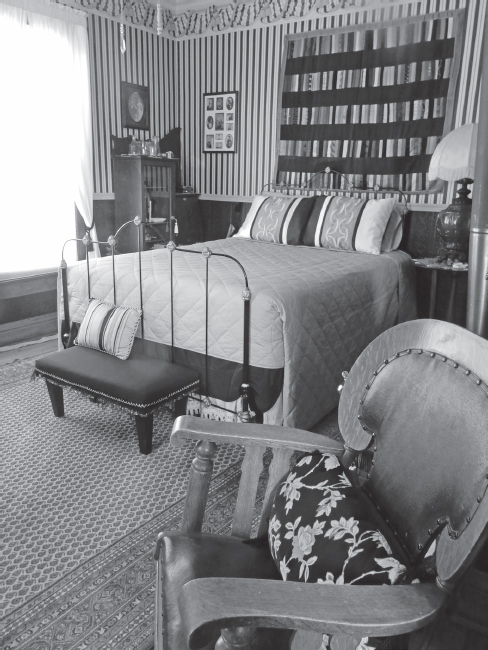
A lot of paranormal activity has been noticed in the Millard Room. Courtesy of Wendy Williams.
A team of paranormal investigators recorded wide variations on their EMF (electromagnetic field) meters in the bedrooms. They recorded several different voices that were picked up by their spirit box in these rooms. They were able to identify the words, “girl, ghosts, blood, death,” and “bones,” all given in response to their questions.